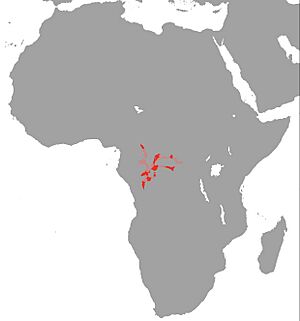Barred bichir facts for kids
Quick facts for kids Barred bichir |
|
|---|---|
 |
|
| Barred bichir at the New England Aquarium | |
| Conservation status | |
| Scientific classification | |
 |
|
| Synonyms | |
|
The barred bichir (Polypterus delhezi) is a unique type of fish. It is also known as the armoured bichir or banded bichir. This fish belongs to a group called Actinopterygii, or ray-finned fish. These fish have fins supported by bony rays.
Barred bichirs are long, snake-like fish. They live in the Congo River in Africa. You can find them mostly in the upper and middle parts of the river. This fish is quite popular in pet stores. It was named after Henri Paul Delhez, a Belgian artist and naturalist.
Contents
What Does a Barred Bichir Look Like?
Barred bichirs are usually grey. They can also have small specks of yellow or green. Their underside is lighter than their back. These fish are special because they are from a very old group of fish. They have many features that make them different from other fish.
Unique Fins and Body
The dorsal fin (on its back) is very distinct. It is made of several separate spines. Their body is mostly made of cartilage, like a shark's. Cartilage is a flexible material. Their jawbones are also very old-fashioned. They look more like a salamander's jaw than a typical fish's.
How They Breathe: A Special Lung
One amazing thing about the barred bichir is its modified swim bladder. Most bony fish have a swim bladder. This is a gas-filled organ inside their body. It helps them float at different water depths. But in the barred bichir, the swim bladder works like a lung!
This swim bladder has two parts. The right part is much bigger. It helps the fish breathe air. This means a barred bichir can survive out of water for a while. It just needs to stay moist. Because of this, the Polypterus group is the only known vertebrate (animal with a backbone) that has lungs but no trachea (windpipe).
Ancient Scales
The scales of the barred bichir also show its ancient origins. Fish scales come in many shapes and sizes. They can help identify a fish species. Bichir scales are primitive. Each scale is covered with a substance called 'ganoin'. This substance is similar to tooth enamel.
These scales are called ganoid scales. You can find similar scales on sturgeons and gars. Ganoid scales are thicker than other types. They connect with each other like pegs and sockets. This means they do not overlap. Each scale is shaped like a diamond.
Jaw Shape for Hunting
Barred bichirs are also known as "upper-jawed" Polypterus. This means their upper jaw sticks out further than their lower jaw. Their jaw shape is similar to very early ray-finned fish. This suggests it's a very old feature for bony fish. This jaw shape helps the bichir eat. They can suck smaller animals into their mouth.
Where Do Barred Bichirs Live?
The barred bichir was first found in the Congo River. It is common in the upper and middle parts of this river. This area is in Central Africa. Even though they are only found in this small wild region, they are bred in captivity. This makes them a common pet fish for aquariums.
Barred Bichir Habits and Behavior
Barred bichirs are nocturnal. This means they are active at night. They rely a lot on their sense of smell. Their eyesight is not very good. They use smell to hunt and find food.
In the wild, barred bichirs hide during the day. They come out at night to hunt. They are carnivores, meaning they eat meat. Their diet includes almost anything they can suck into their mouths. This includes small fish, insects, and worms. Pet bichirs also love meat. They often enjoy shrimp, prawns, and mussels.


